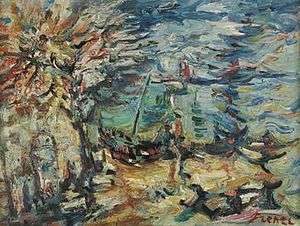Yitzhak Frenkel
Yitzhak Frenkel (Hebrew: יצחק פרנקל; 1899–1981), also known as Alexandre Frenel, was an Israeli painter.

Early life
Yitzhak Frenkel was born in 1899 in Odessa, Russian Empire. He was a great-grandson of the famous Rabbi Levi Yitzchok of Berditchev. In 1917, he studied under Aleksandra Ekster at the Fine Arts Academy in Odessa. Frenkel immigrated to Mandate Palestine in 1919 as part of the first wave of settlers of the Third Aliyah. He died in Tel Aviv in 1981 and was buried in Safed.
Art Of Frenkel Frenel in the 1920s and 1930s
In 1920, he established the artists' cooperative in Jaffa and an artists' studio in Gymnasia Herzliya where gave lessons in painting and sculpture. Later that year, he traveled to Paris where he studied at the École des Beaux-Arts and at the Académie de la Grande Chaumière[1] at the studios of the sculptor Antoine Bourdelle and painter Henri Matisse. At the time his painting were abstract. Towards the end of 1920, Frenkel Frenel traveled to Egypt where he showcased his works in an exhibition before returning to Paris.
Frenkel returned to Palestine in 1925 and opened the Histadrut Art School in Tel Aviv. In Israel he was considered extreme in his artistic orientations. His students included Shimshon Holzman, Mordechai Levanon, David Hendler, Joseph Kossonogi, and Siona Tagger. He was a mentor to Bezalel students Avigdor Stematsky, Yehezkel Streichman, Moshe Castel, and Arie Aroch. All those who studied under him absorbed French influence and most them would go to learn in Paris in the 1920s and 1930s. Frenkel's style was closer to the abstract painting to which he was exposed in Paris than the orientalism that was popular in Palestine at that time.
In 1926, he presented in the "Ohel" theater his abstract work, compositions of geometric shapes and alongside them landscape paintings. In this period an expressionistic tendency in his work begins to arise, especially in his choice of colour. By the time he returned to Paris in 1929 his expressionist style came into form.
In 1934 he made Safed his home, becoming the first artist to settle in the ancient holy city, 14 years before the "Artists' Colony" was formally established. There he painted the ancient synagogues, narrow lanes, local inhabitants and surrounding countryside.[2] During that period he completely abandons the abstract style and embarks in the search of other, vibrant styles. In that same he year he designed the "Adloyada" carnival in Tel Aviv. In 1936 he began designing sets and costumes for the "HaOhel" theater. He will continue engaging in the sort of work until 1949, continuing his work both for the "HaOhel" theater as well as the "HaBima" theater. During that same period he also painted portraits of several famous actors who worked for the said theaters.
In 1937 he embarked on a journey, painting Israel from point to point, North to South. He painted Safed, Jerusalem, Tel Aviv, the Negev desert as well as the Galilee. He made 13 exhibitions on the motif of Safed up-to 1950.
Art in the 1940s and onwards: historical artist and international success
In the year 1948, the year of Israel's independence, he will be allowed to record historic milestones in the Israel's story. Painting the first meeting of the Knesset as well as the first meeting of the military committee of the IDF. He also made portraits of the first 120 MKs (Members of the Knesset).[3]
In 1949, he would become one of the founders of the "Artists Colony of Safed". In 1950 he exhibited his work in the first and second Bienniale of Venice, representing Israel. In 1952 he exhibited again in Paris. In France he created vitrages (Window glass work), which were ordered by the Baroness Alix de Rothshild at Normandy in the north of France. He is considered one of the most important Jewish "École de Paris" painters; along with Soutine, Mogdiliani, Kikone, Kremegne, Manne Katz and Paskin. He presents his work in one-man shows all over the world. By 1960 he had presented his works in one-man shows in museums and galleries stretching the globe from Europe and the Americas to South Africa and Asia. From 1960 he lives in Paris and uses Tzfat/Safed as his summer home.
In 1973, his house reopened as a museum showcasing his work. In July 1978, Frenkel had a one-man show at the Orangerie in Paris.[1]
Expressionist works of Frenkel pinpoint the expression of inner experience rather than solely realistic portrayal, seeking to depict not objective reality but the subjective emotions and responses that objects and events arouse in them. His exalts colours reveal his most hidden emotions and express passion and drama. When he paints his wife Ilana, the colours express an erotical explosion.[4]
In 1979 he had a One-man show at the famous "Orangerie" of Paris, in celebration of his 80th birthday.
He died in 1981 in Tel Aviv and was buried in Safed.
Awards and commemoration
Frenkel won the Dizengoff Prize for painting twice, in 1938 and again in 1948.[5] He took part in the first and second Venice Biennales.
Selected exhibitions
- 1950: Venice Biennale
- 1924: Salon des Indépendants, Paris
Prizes
-Dizengoff Prize (Tel Aviv) 1935;1938;1939;1940;1948
-1st Prize for Litography-French pavilion-in the International Lithography Exhibition (Bruxelles Belgium) 1958
-Grand prix de Paques(nude) 1972
-Grand prix de Noel (expressionism) 1972
-Grand prix International de Peinture de la Côte d’Azur en Frande Finale 1973
-Grand prix International de Deauville 1973[6]
Selected collections
- Israel Museum, Jerusalem
See also
References
- Alexandre Frenel (Isaac Frenkel aka) - Odessa - 1899 - Tel Aviv - 1981
- A house in Safed
- "FRENKEL FRENEL MUSEUM". www.frenkel-frenel.org. Retrieved 2019-08-09.
- "Expressionism". www.frenkel-frenel.org. Retrieved 2019-08-09.
- "List of Dizengoff Prize laureates" (PDF) (in Hebrew). Tel Aviv Municipality.
- "Yitzhak Alexander Frenkel Frenel". www.frenkel-frenel.org. Retrieved 2019-08-08.
Further reading
- Barzel, Amnon. Isaac Alexander Frenel. Jerusalem: Massada Press, 1974.
- Gumprecht-Linke, S. Frenel: École de Paris. Amsterdam: Israel Galerie Linka, 1977.